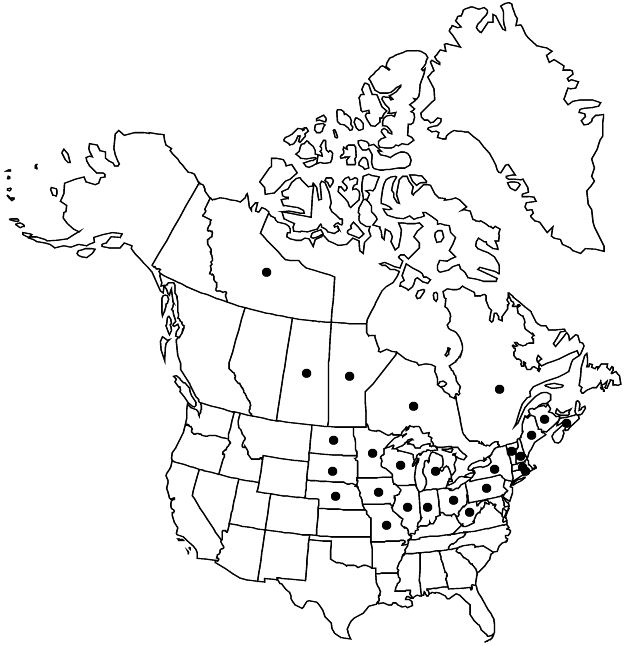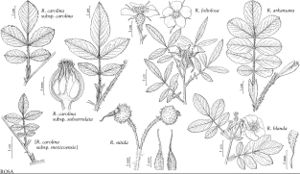Rosa blanda
Hort. Kew. 2: 202. 1789.
Shrubs, forming thickets. Stems erect or arching, (5–)10–20 dm, sparsely branched; bark green when young, red to orange-red with age, proximally glaucous, glabrous; infrastipular prickles absent, internodal prickles rare, sparse, distal aciculi rare. Leaves 8.5–11 cm; stipules (9–)15–25 × 4–6 mm, auricles usually flared, (2.5–)4–6 mm, margins entire or serrate, sparsely to densely stipitate-glandular, surfaces glabrous, sometimes pubescent, eglandular or glandular; petiole and rachis with pricklets rare or absent, glabrous or puberulent to pubescent, sessile- or stipitate-glandular, sometimes eglandular; leaflets 5–7(–9), terminal: petiolule 5–9(–13) mm, blade elliptic or ovate, sometimes obovate, (15–)25–40(–55) × (8–)12–20(–30) mm, membranous, margins 1-serrate, teeth 10–26 per side, acute, sometimes black gland-tipped, apex acute, sometimes obtuse, abaxial surfaces pale green, glabrous, sometimes pubescent or tomentulose, eglandular, adaxial green, dull to ± lustrous, glabrous, sometimes marginally hairy. Inflorescences corymbs, 1–5(–10)-flowered. Pedicels erect, slender, 14–25 mm, glabrous, eglandular, rarely sparsely stipitate-glandular; bracts 1 or 2, ovate-lanceolate, 14–20 × 2–8 mm, margins entire, sometimes undulate, irregularly serrate, short stipitate-glandular, surfaces glabrous, glandular. Flowers 3–6(–7) cm diam.; hypanthium ovoid or globose, 4–5 × 4.5–5 mm, glabrous, eglandular, rarely stipitate-glandular, neck (0–)0.5–0.8 × 3–3.5 mm; sepals usually erect usually forming a beak-cap or ± reflexed, ovate-lanceolate, (12–)20–30 × 2.5–3.5 mm, tip 2.5–4 × 0.5–1.5 mm, margins entire or pinnatifid, abaxial surfaces glabrous, stipitate-glandular, rarely eglandular; petals single, pink or rose, 13–26 × 12–26 mm; stamens 115; carpels 32–55, styles exsert 1–2 mm beyond stylar orifice (1.5 mm diam.) of hypanthial disc (4 mm diam.). Hips red, subglobose to globose, sometimes ellipsoid, urceolate, or pyriform, 8–11 × 8–11 mm, fleshy, glabrous, eglandular, rarely sparsely stipitate-glandular, neck (0–)0.5–1(–1.5) × 3.5–4.5 mm; sepals persistent, erect or reflexed. Achenes basiparietal, 26, tan, 3.5–4 × 1.5–3 mm. 2n = 14.
Phenology: Flowering Jun–Jul.
Habitat: Thickets, grassy verges, edges of woods, ditches, stream banks, gravelly and sandy flats
Elevation: 0–700 m
Distribution

Man., N.B., N.W.T., N.S., Ont., Que., Sask., Ill., Ind., Iowa, Maine, Mass., Mich., Minn., Mo., Nebr., N.H., N.Y., N.Dak., Ohio, Pa., R.I., S.Dak., Vt., W.Va., Wis., introduced in c Europe.
Discussion
Rosa blanda is best recognized by its erect, slender distal stems and branches without armature or, rarely, with internodal prickles and/or aciculi. In addition, auricles are flared, 4–6 mm; abaxial surfaces of sepals are stipitate-glandular, usually forming an erect beak-cap, and an average stamen number of 115, nearly double that of R. woodsii with 65.
M. Mercure and A. Bruneau (2008) described and genetically confirmed spontaneous hybrids between Rosa blanda and R. rugosa forming colonies along the St. Lawrence Estuary, Quebec. Analyses indicated that most of the hybrids were first generation; second generation and backcrosses were also detected. This is a recently established hybrid zone with the potential for introgression of the aggressive R. rugosa into native R. blanda and thereby a serious threat to the integrity of the native species.
A. Bruneau et al. (2007) found that, within Rosa blanda, previously recognized segregate species (R. johannensis, R. rousseauiorum, R. subblanda, R. williamsii) should not be considered specifically distinct from R. blanda, although populations representing R. williamsii might be worthy of subspecific recognition.
Selected References
None.
